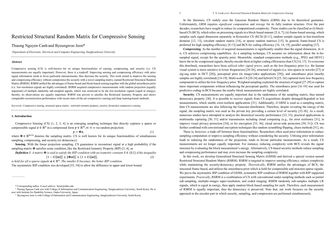Restricted Structural Random Matrix for Compressive Sensing
Compressive sensing (CS) is well-known for its unique functionalities of sensing, compressing, and security (i.e. CS measurements are equally important). However, there is a tradeoff. Improving sensing and compressing efficiency with prior signal information tends to favor particular measurements, thus decrease the security. This work aimed to improve the sensing and compressing efficiency without compromise the security with a novel sampling matrix, named Restricted Structural Random Matrix (RSRM). RSRM unified the advantages of frame-based and block-based sensing together with the global smoothness prior (i.e. low-resolution signals are highly correlated). RSRM acquired compressive measurements with random projection (equally important) of multiple randomly sub-sampled signals, which was restricted to be the low-resolution signals (equal in energy), thereby, its observations are equally important. RSRM was proven to satisfies the Restricted Isometry Property and shows comparable reconstruction performance with recent state-of-the-art compressive sensing and deep learning-based methods.
PDF Abstract
